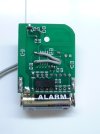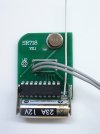Al the main 6 muxes at CP are from the same antennas and have the same, nominal, effective radiated powers and pattern (there are minor, and I mean minor variations with frequency of course). All six should be received at near-equal level.
My gut is saying there's cancellations and reinforcements of the different frequencies occurring to give such a measured level variation in levels.
Woking is probably
not line of sight to CP so the signals will be diffracted which can give rise to that. As may reception through trees (deciduous leaf sizes matching certain wavelength). Wolfbane will provide path profile plots based on postcode centre. Note that Reigate is now (since the 700 MHz clearance) in a single frequency network (SFN) with CP for those six and, although the 'other polarisation' may contribute something into the reception pot in Woking.
CP Main vs Reserve antenna working (reserve being lower) would change the received signal patterns (as well as having a different radiation pattern / frequency due to the design and necessary location.
Local TV is on a much lower level off one of the tower legs; but uses a more robust transmission mode that (IIRC) is equivalent to a 10dB power gain?
With cancellation / reinforcement (sometimes known as 'standing waves') antenna positioning is crucial to get as near to equal received levels as possible. Raising the antenna higher/lower, crabbing left/right and fore/aft (always pointing the aerial to the transmitter) should find the 'sweet spot'. A spectrum analyser type display that professional installer meters have will help to achieve this. The meter being purchased seems to offer that, or a quite similar, feature from a quick scan of the manual.
This is not something most would be advised to attempt on a rooftop (thinks Rod Hull) and is maybe best left to the professionals. You may possess the necessary safe access equipment and skills though?
Justin of ATV aerials in Sheffield favours the Yagi 18 he sells as being better built and more robust than any x-element design
https://www.aerialsandtv.com/product/yagi-18a-aerial
He also sells the XB10A and XB16A - but I'm not sure you really need the small extra gain over the Yagi 18.





